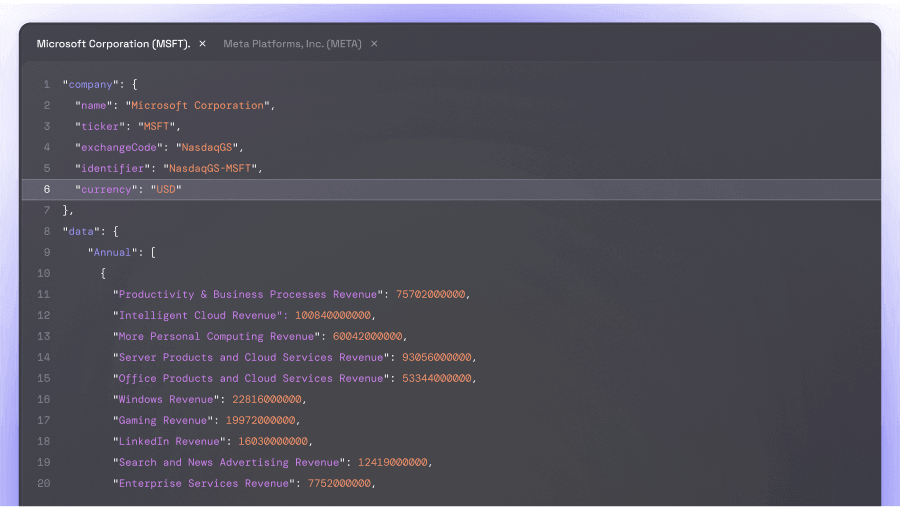Stock Index: NASDAQ 100 Stocks
Eulerpool has compiled a list of stocks in the NASDAQ 100 Index for you. The specifics and structure of this index will be explained below.
The Modern Financial Terminal
Trusted by leading companies and financial institutions
Stocks in the NASDAQ 100
General Information
The NASDAQ 100 is a stock index for primarily American technology companies. It includes the most valuable 100 non-banking companies listed on the American stock exchange Nasdaq. The size of these companies ranges from Apple with a valuation of over three trillion US dollars to 12 billion dollars for Peloton (Indoor-Bikes).
This index is published by the US stock exchange Nasdaq (abbreviation for National Association of Securities Dealers Automated Quotations).
The NASDAQ 100 is internationally renowned and relevant. It is often used to assess the entire technology and software sector.
Master data
| Country | USA |
|---|---|
| Stock Exchange | NASDAQ |
| ISIN | US6311011026 |
| ISIN Anzeigen Kurs Tageshoch Tagestief Vortag Eröffnung 52 W. Tief 52 W. Hoch Volumen Marktkapitalisierung Dividendenrendite Geschäftsjahr KGV KBV KCV KUV AlleAktien Fair Value | A0AE1X |
| Bloomberg Code | NDX |
| Category | Stock index |
| e: "AlleAktien" or "Fair Value" remains the same in English as well. Please do not translate these words. | Price index |
Calculation of the index
The value of this index is calculated on trading days during the opening hours of the Nasdaq exchange. These are in Central European Time from 3:30 pm to 10:00 pm. During this period, the index price is updated once per second.
The calculation is based on the so-called value index formula. This calculation takes into account the performance of each individual stock.
These individual changes are additionally weighted. This means that the largest company has more influence on the index than the smallest firm. Criteria for this weighting are market capitalization and the number of freely tradable shares.
The most important criteria for inclusion in the index is market capitalization. In addition, a candidate must have a high trading volume and have been listed on the Nasdaq for at least two years. The inclusion of new companies and the exclusion of companies included in the index is typically decided once a year.
In general, the index is considered well diversified. There are a lot of companies with a medium-sized market capitalization.
Overview of the Index History
The NASDAQ 100 was established on 31.01.1985. On this day, a starting value of 250 points was attributed to it. Nine years later, the index was split in a ratio of 2:1. This means that all previously calculated prices are halved. Therefore, the new base value is 125 points.
The technology bubble (also known as the dotcom bubble) from 2000-2003 hit the Nasdaq particularly hard. However, prior to the bubble's inflation, the index rose approximately 3,600% in just 15 years. This corresponds to an annual return of approximately 27%!
Accordingly, the crash after the burst was also severe. From over 4,700 points in March 2000, it decreased by about 80% to 800 points in October 2002. The Nasdaq also lost over 50% during the financial crisis. At its lowest point in March 2009, the index had a value of only 1,040 points.
In the last 12 years, the Nasdaq has been in a strong uptrend. In January 2022, the index stands at nearly 16,000 points. One of the reasons for this rapid development is the growth of tech giants like Apple, Microsoft, and Co.
Historical Price Performance
If an investor had invested $1,000 in this index at the start of 1985, this investment would be worth approximately $126,400 today. This corresponds to an annual return of almost 14%.
In the past five years, the Nasdaq has gained a total of 213%. This is significantly more than the 82% of the global stock index MSCI World.
Meaning for private investors
Investors have been able to earn a lot of money in the past with the Nasdaq 100. In general, it is noticeable that the fluctuations downwards and upwards are larger than with broader indices. Therefore, an investment in the Nasdaq is more suitable for risk-loving investors.
There are many different ETFs that aim to track this index. Especially in conservative portfolios, such an investment can be a good addition.
However, investors should always keep an eye on the proportion of high-valued technology stocks in their portfolio. This proportion is often relatively high, especially among young investors.

